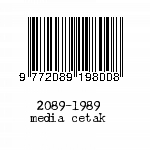Pengaruh Jumlah Uang Beredar dan Kurs terhadap Harga Beras di Indonesia dengan Inflasi sebagai Variabel Intervening
Abstract
The study aims to determine the effect of the money supply and exchange rates on rice prices with inflation as an intervening variable. Secondary data is time series 2015-2019 from BPS and BI, and is analyzed using a path analysis model which is an extension of multiple linear regression. The results showed that the money supply had a negative and significant effect on inflation, while the exchange rate had a positive and insignificant effect on inflation. Another finding is that the money supply has a positive and significant effect on rice prices, the exchange rate has a negative and insignificant effect on rice prices, and inflation has a negative and significant effect on rice prices. The third finding is that inflation as an intervening variable only mediates the money supply to the price of rice.
References
Adhawiyah, R., Prajawati, M. I., & Firdian, R. (2018). Pengaruh paritas daya beli, paritas suku bunga terhadap nilai tukar rupiah dan dollar Amerika Serikat. Iqtishoduna, 14(1), 55-70. doi: 10.18860/iq.v0i0.4839.
Browne, F., & Cronin, D. (2010). Commodity prices, money and inflation. Journal of Economics and Business, 62(4), 331-345. doi: 10.1016/j.jeconbus.2010.02. 003.
Eiteman, D. K., Stonehill, A. I., & Moffett, M. H. (2010). Manajemen keuangan multinasional. Edisi terjemahan, edisi kesebelas. Erlangga.
Faris, M. I. Z. A. (2016). Analisis pengaruh nilai tukar, inflasi, jumlah uang beredar (jub), produksi kedelai dalam negeri dan volume impor kedelai terhadap harga domestik komoditas kedelai. Skripsi (tidak dipublikasikan), Universitas Islam Negeri Sunan Kalijaga. Retrieved from http://digilib. uin-suka.ac.id/24918/.
Ghozali, I. (2018). Aplikasi analisis multivariat dengan program IBM SPSS 25, Badan Penerbit-Undip.
Gilbert, C. L. (2010). How to understand high food prices. Journal of Agricultural Economics, 61(2), 398-425. doi: 10.1111/j.1477-9552.2010.00248.x.
Hayes, A. F. (2009). Beyond Baron and Kenny: Statistical mediation analysis in the new millennium. Communication Monographs, 76(4), 408-420. doi: 10.1080/03637750903310360.
Jumhur, J., Nasrun, M. A., Agustiar, M., & Wahyudi. (2018). Pengaruh jumlah uang beredar, ekspor dan impor terhadap inflasi (Studi empiris pada perekonomian Indonesia). Jurnal Ekonomi Bisnis dan Kewirausahaan, 7(3), 186-201. doi: 10.26418/jebik. v7i3.26991.
Langi, T. M., Masinambow, V., & Siwu, H. (2014). Analisis pengaruh suku bunga bi, jumlah uang beredar, dan tingkat kurs terhadap tingkat inflasi di Indonesia. Jurnal Berkala Ilmiah Efisiensi, 14(2), 44-58. Retrieved from https://ejournal.unsrat.ac.id/index.php/jbie/article/view/4184/3713.
Larasati, D. M., & Amri, A. (2017). Pengaruh tingkat suku bunga sertifikat Bank Indonesia dan nilai tukar terhadap inflasi di Indonesia. Jurnal Ilmiah Mahasiswa Ekonomi Pembangunan, 2(4), 535-543. Retrieved from http:// www.jim.unsyiah.ac.id/EKP/article/view/5728.
Lim, Y. C., & Sek, S. K. (2015). An examination on the determinants of inflation. Journal of Economics, Business and Management, 3(7), 678-682. doi: 10.7763/JOEBM.2015.V3. 265.
Madesha, W., Chidoko, C., & Zivanomoyo, J. (2013). Empirical test of the relationship between exchange rate and inflation in Zimbabwe. Journal of Economics and Sustainable Development, 4(1), 52-59. Retrieved from https://www.iiste.org/Journals/ index.php/JEDS/article/view/4096.
Mahendra, A. (2016). Analisis pengaruh jumlah uang beredar, suku bunga sbi dan nilai tukar terhadap inflasi di Indonesia. JRAK: Jurnal Riset Akuntansi dan Keuangan, 2(1), 1-12. doi: 10.1234/akuntansi.v2i1.170.
Malian, A. H., Mardianto, S., & Ariani, M. (2004). Faktor-faktor yang mempenga-ruhi produksi, konsumsi dan harga beras serta inflasi bahan makanan. Jurnal Agro Ekonomi, 22(2), 119-146. doi: 10.21082/jae.v22n2.2004.119-146.
Maune, A., Matanda, E., & Mundonde, J. (2020). Is money supply the cause of inflation in Zimbabwe? An empirical examination. Acta Universitatis Danubius. Œconomica, 16(3), 17-37. Retrieved from https://dj.univ-danubius.ro/index.php/AUDOE/article/view/372.
Mbongo, J. E., Mutasa, F., & Msigwa, R. E. (2014). The effects of money supply on inflation in Tanzania. Economics, 3(2), 19-26. doi: 10.11648/J.ECO.20140302. 11.
Muljawan, R. E., & Alibaba, R. B. (2009). Faktor-faktor yang mempengaruhi harga beras di Jawa Timur. Buana Sains, 9(2), 111-118. doi: 10.33366/bs. v9i2.230.
Namira, Y., Nuhung, I. A., & Najamuddin, M. (2017). Analisis faktor-faktor yang mempengaruhi impor beras di Indonesia. Jurnal Agribisnis, 11(2), 183-201. doi: 10.15408/aj.v11i2.11843.
Ningsih, S., & Kristiyanti, L. M. S. (2018). Analisis pengaruh jumlah uang beredar, suku bunga, dan nilai tukar terhadap inflasi di Indonesia periode 2014-2016. Daya Saing: Jurnal Ekonomi Manajemen Sumber Daya, 20(2), 96–103. doi: 10.23917/dayasaing.v20i2. 7258.
Nopirin. (2000). Ekonomi moneter. BPFE-UGM.
Perlambang, H. (2012). Analisis pengaruh jumlah uang beredar, suku bunga SBI, nilai tukar terhadap tingkat inflasi. Media Ekonomi, 19(2), 49-68. doi: 10.25105/me.v18i2.2251.
Putra, M. I. (2014). Determinasi kenaikan harga pangan di Indonesia (Pangan padi, kedelai periode 2001-2011). Jurnal Imliah Mahasiswa FEB Universitas Brawijaya, 3(1), 1-16. Retrieved from https://jimfeb.ub.ac.id/ index.php/jimfeb/article/view/1387.
Putra, Y. P. (2017). Analisis pengaruh harga beras, produksi beras dan PDRB terhadap inflasi di Indonesia tahun 2010 – 2015. Jurnal Ilmiah Mahasiswa FEB Universitas Brawijaya, 5(2), 1-24. Retrieved from https://jimfeb.ub.ac.id/ index.php/jimfeb/article/view/5368.
Radjab, E., & Jam’an, A. (2017). Metode penelitian bisnis (1st ed.), Lembaga Perpustakaan dan Penerbitan Universitas Muhammadiyah Makassar.
Rahadyan, H., & Lubis, A. (2018). Monetary integration in the ASEAN economic community challenge: The role of the exchange rate on inflation in Indonesia. International Journal of Services, Technology and Management, 24(5-6), 463-479. doi: 10.1504/IJSTM.2018. 094438.
Rahmanta, & Maryunianta, Y. (2020). Pengaruh harga komoditi pangan terhadap inflasi di kota Medan. Jurnal Agrica, 13(1), 35-44. doi: 10.31289/ agrica.v13i1.3121.
Rahmawati, D., Hidayat, W., & Susilowati, D. (2017). Analisis pengaruh suku bunga sertifikat Bank Indonesia dan jumlah uang beredar terhadap tingkat inflasi di Indonesia periode 2006-2015 (Pendekatan error correction model). Jurnal Ilmu Ekonomi, 1(2), 240-254. Retrieved from https://ejournal.umm. ac.id/index.php/jie/article/view/5409.
Rezitis, A. N. (2015). The relationship between agricultural commodity prices, crude oil prices and US Dollar exchange rates: A panel VAR approach and causality analysis. International Review of Applied Economics, 29(3), 403-434. doi: 10.1080/02692171. 2014.1001325.
Saputra, A., Arifin, B., & Kasymir, E. (2014). Analisis kausalitas harga beras, harga pembelian pemerintah (HPP) dan inflasi serta efektivitas kebijakan HPP di Indonesia. Jurnal Ilmu Ilmu Agribisnis, 2(1), 24-31. doi: 10.23960/ jiia.v2i1.24-31.
Setyoaji, S. B., Hani, E. S., & Sunartomo, A. F. (2014). Faktor-faktor yang mempengaruhi fluktuasi harga beras IR-64 premium 2015-2020 di Jawa Timur. Berkala Ilmiah Pertanian, 1-11. Retrieved from http://repository.unej. ac.id/handle/123456789/69517.
Suarsih, S., Achasin, N. A., & Nuryartono, N. (2016). Dampak perubahan nilai tukar terhadap indeks harga konsumen bahan makanan di Indonesia. Jurnal Ekonomi dan Pembangunan Indonesia, 17(1), 1-14. doi: 10.21002/jepi.v17i1.548.
Suharjo, B. (2013). Statistika terapan disertai contoh aplikasi dengan SPSS, Graha Ilmu.
Taylor, A. M., & Taylor, M. P. (2004). The purchasing power parity debate. Journal of Economic Perspectives, 18(4), 135-158. doi: 10.1257/08953300 42632744.
Utami, A. T., & Soebagiyo, D. (2013). Penentu inflasi di Indonesia; Jumlah uang beredar, nilai tukar, ataukah cadangan devisa?. Jurnal Ekonomi & Studi Pembangunan, 14(2), 144-152. Retrieved from https://journal.umy. ac.id/index.php/esp/article/view/1266/ 1321.


















